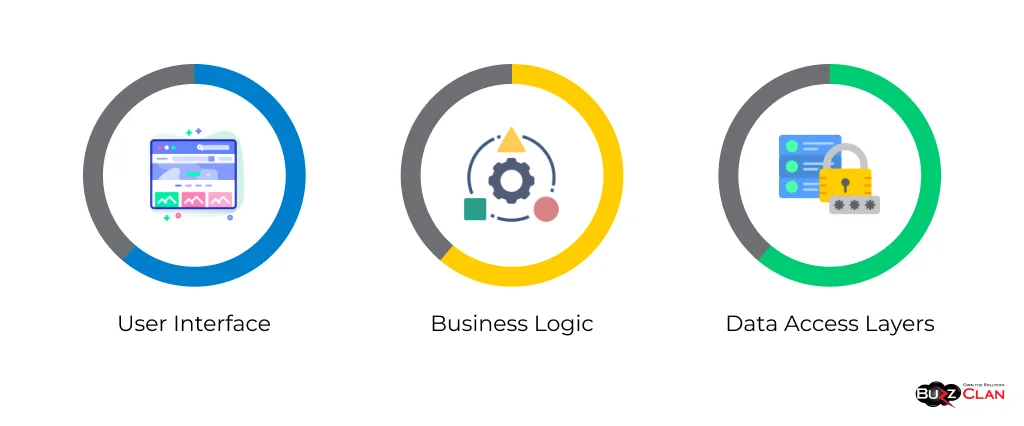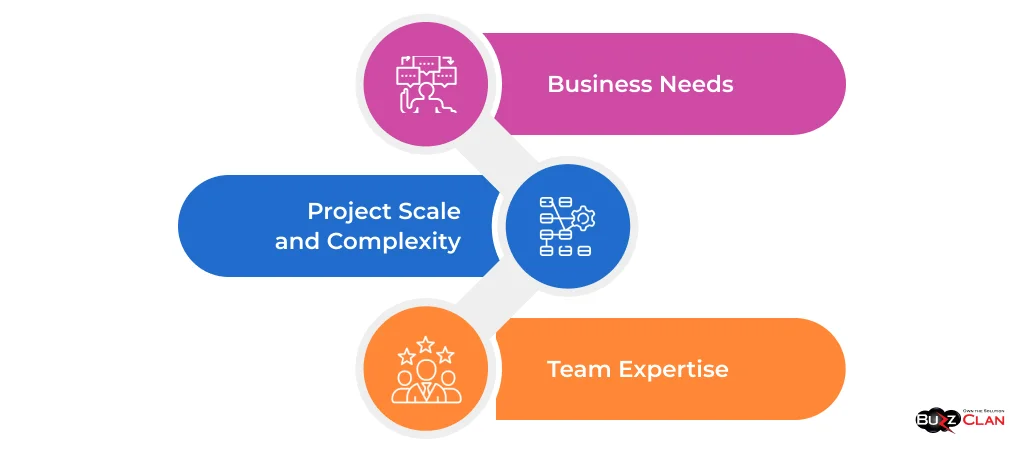Monolithic vs Microservices Architecture: Choosing the Right Approach
Rohan Rao
Jul 3, 2024
Introduction
In modern software development, the debate between microservices and monolithic architectures has been a topic of great interest and discussion. As businesses strive to create scalable, flexible, and maintainable applications, choosing between these architectural approaches can significantly impact a project’s success. While both architectures have merits and drawbacks, understanding their differences and suitability for various scenarios is crucial for making informed decisions.
In this comprehensive blog post, we will delve into the intricacies of microservices and monolithic architectures, providing a detailed comparison to help you grasp the strengths and weaknesses of each approach. We will explore both architectures’ definitions, benefits, drawbacks, and use cases and the key factors to consider when choosing between them. By the end of this post, you will have a clearer understanding of which architecture aligns best with your project’s requirements and goals.
Understanding Monolithic Architecture

A monolithic architecture is a traditional software design pattern where an application is built as a single, self-contained unit. In a monolithic structure, all the functionalities and components of the application are tightly coupled and run as a single process. The application typically uses a single technology stack and shares a common database.
The main components of a monolithic application include the user interface, business logic, and data access layers, all bundled together into a single executable or deployable unit. This architecture has been the predominant approach for building software applications for many years, with its roots dating back to the early days of software development.
Understanding Microservices Architecture
On the other hand, Microservices architecture is a modern architectural style where an application comprises small, independent services that communicate with each other through well-defined APIs. Each microservice focuses on a specific business capability and can be developed, deployed, and scaled independently of other services.
In a microservices architecture, each service has its database and runs as a separate process. The services communicate with each other using lightweight protocols such as HTTP/REST or message queues. This approach allows for greater flexibility, scalability, and modularity than monolithic architectures.
The rise of microservices can be attributed to the need for more agile and scalable solutions in the era of cloud computing and digital transformation. Companies like Amazon, Netflix, and Uber have successfully adopted microservices architectures to handle their complex and rapidly growing applications.
Key Differences Between Monolith and Microservices
| Aspect | Description |
|---|---|
| Architecture | A single, tightly coupled codebase characterizes monolithic architecture, while microservices architecture consists of loosely coupled, independently deployable services. In a monolithic system, all components are interconnected and share the same resources, whereas microservices have clear boundaries and communicate through APIs. |
| Development and Deployment | The entire application is developed, tested, and deployed as a single unit in a monolithic architecture. Any changes or updates require rebuilding and redeploying the entire application. Microservices, however, allow for the independent development and deployment of individual services. Each service can be built using different technologies and deployed separately, enabling faster development cycles and more frequent updates. |
| Scalability | Monolithic applications can be challenging to scale horizontally, as the entire application needs to be replicated on multiple servers. Vertical scaling, by adding more resources to a single server, is often the only option. Microservices, however, can be scaled independently based on the demand for each service. This allows for more efficient resource utilization and better scalability. |
| Maintenance and Updates | Maintaining and updating a monolithic application can be complex and time-consuming. Any changes to one part of the application can have unintended consequences on other parts, making it difficult to introduce new features or fix bugs. With microservices, each service can be maintained and updated independently, reducing the risk of breaking the entire application and allowing for faster iteration. |
Benefits of Monolithic Architecture

- Simplicity
Monolithic architectures offer simplicity in terms of development and deployment. With a single codebase and shared resources, developers can have a unified view of the entire application, making it easier to understand and modify. Deployment is also simpler, as the entire application can be packaged and deployed as a single unit.
- Performance
In certain scenarios, monolithic applications can offer better performance compared to microservices. Since all components are tightly coupled and run in the same process, there is less overhead regarding inter-process communication and data sharing. This can lead to faster response times and lower latency, especially for applications with heavy read operations.
- Easier Testing
Testing a monolithic application is generally easier compared to microservices. End-to-end testing can be performed more efficiently with a single codebase, as all components are readily available and can be tested together. This reduces the complexity of setting up test environments and ensures coverage of comprehensive application functionalities.
Drawbacks of Monolithic Architecture
- Scalability Issues
As mentioned earlier, scaling monolithic applications can be challenging. Horizontal scaling requires replicating the entire application on multiple servers, which can be resource-intensive and inefficient. This limits the ability to scale individual components based on demand, leading to over-provisioning or under-utilizing resources.
- Maintenance Challenges
Maintaining a monolithic application becomes increasingly difficult as the codebase grows in size and complexity. With tightly coupled components, making changes or adding new features can be time-consuming and error-prone. Any modifications require careful consideration and extensive testing to ensure the entire application remains stable and functional.
- Limited Flexibility
Monolithic architectures can hinder flexibility and innovation. Since all components are interconnected, introducing new technologies or frameworks can be challenging without impacting the entire application. This can lead to technology lock-in, making it difficult to adopt new tools or adapt to changing business requirements.
Benefits of Microservices Architecture

- Scalability
Microservices architecture excels in terms of scalability. Each service can be scaled independently based on its specific resource requirements and demand. This allows for fine-grained scalability, where individual services can be scaled up or down without affecting the entire application. This leads to more efficient resource utilization and cost optimization.
- Flexibility
Microservices offer increased flexibility and innovation opportunities. Each service can be developed using different technologies, frameworks, or programming languages best suited for its specific functionality. This allows teams to choose the right tools for the job and experiment with new technologies without impacting the entire application. Microservices also enable faster time-to-market for new features and services.
- Independent Deployment
With microservices, each service can be deployed independently without affecting the availability or functionality of other services. This enables continuous deployment and faster release cycles. Teams can work on different services simultaneously, reducing dependencies and allowing for more frequent updates and bug fixes.
Drawbacks of Microservices Architecture
- Complexity
Microservices architecture introduces additional complexity in development, deployment, and management. With numerous services interacting, there is an increased need for coordination and communication between teams. Managing dependencies, versioning, and ensuring compatibility between services can be challenging. Monitoring and debugging distributed systems also becomes more complex.
- Communication Overhead
In a microservices architecture, services communicate through APIs or message queues. This inter-service communication introduces overhead regarding network latency and data serialization/deserialization. Poorly designed or inefficient communication patterns can lead to performance degradation and increased complexity.
- Testing Difficulties
Testing microservices can be more challenging compared to monolithic applications. With services being developed and deployed independently, ensuring end-to-end functionality and identifying issues across service boundaries require extensive integration testing. Setting up test environments replicating the production environment can be complex and time-consuming.
Use Cases and Examples
- Monolithic Architecture Use Cases
Monolithic architectures are well-suited for smaller applications with a limited set of functionalities. They are also a good fit for applications with tight coupling between components and strong consistency requirements. Examples include simple web applications, content management systems, and legacy systems that have been used for a long time.
- Microservices Architecture Use Cases
Microservices architecture is ideal for large-scale, complex applications that require high scalability, flexibility, and fault tolerance. It is particularly useful for applications with distinct business capabilities that can be developed and deployed independently. Examples include e-commerce platforms, streaming services, and cloud-native applications.
Case Studies
Many companies have successfully adopted microservices architectures for their growing and evolving applications. Netflix, for instance, has been a pioneer in adopting microservices, using it to scale its streaming platform and handle billions of daily requests. Amazon has also leveraged microservices to build its highly scalable and resilient e-commerce platform. Other notable examples include Spotify, Uber, and Twitter.
Modular Monolith: A Middle Ground
- Definition and Concept
A modular monolith is an architectural approach that aims to balance the simplicity of monolithic architectures with the benefits of microservices. The application is divided into loosely coupled modules or components with clear boundaries and well-defined interfaces in a modular monolith. Each module encapsulates a specific business capability and can be developed and tested independently.
- Benefits and Drawbacks
Modular monoliths offer some of the benefits of microservices, such as improved modularity, maintainability, and testability, while retaining monolithic architectures’ simplicity and performance advantages. However, they may not provide the same scalability and flexibility as true microservices architectures.
- Use Cases
Modular monoliths can be a good choice for moderately complex applications that require some degree of modularity and maintainability. They can also be a stepping stone towards a full microservices architecture, allowing teams to refactor and decouple components gradually over time.
Decision-Making Factors

- Business Needs
The choice between monolithic and microservices architectures should be driven by the organization’s specific business needs and goals. Factors such as scalability requirements, time-to-market pressures, and the need for flexibility and innovation should be considered. Understanding the application’s long-term vision and growth prospects is crucial in making the right architectural decision.
- Team Expertise
The development team’s expertise and experience play a significant role in the success of any architectural approach. Microservices architectures require higher expertise in distributed systems, DevOps practices, and inter-service communication. If the team lacks the necessary skills and experience, adopting a microservices architecture may lead to increased complexity and challenges.
- Project Scale and Complexity
The scale and complexity of the project are important factors to consider when choosing between monolithic and microservices architectures. Smaller projects with limited functionalities may benefit from the simplicity of a monolithic approach, while larger projects with diverse business capabilities may be better suited for microservices. The complexity level in data consistency, transaction management, and inter-component dependencies should also be considered.
Community Insights
- Industry Opinions
The debate between monolithic and microservices architectures has been a hot topic in the software development community. Industry experts and developers have shared their insights and experiences, highlighting the pros and cons of each approach. Some advocate for monolithic architectures’ simplicity and performance benefits, while others emphasize microservices’ scalability and flexibility advantages.
- Reddit Discussions
Reddit has been a platform for lively discussions on monolith vs. microservices. Developers from various backgrounds have shared their opinions, real-world experiences, and lessons learned. Some key points from these discussions include considering the project’s specific needs, the challenges of managing complexity in microservices architectures, and the potential benefits of modular monoliths as a middle ground.
Future Trends
- Emerging Technologies
As technology evolves, new trends and innovations may impact the future of monolithic and microservices architectures. Serverless computing, for example, is gaining traction and enables developers to focus on writing code without worrying about infrastructure management. This could simplify the deployment and scaling of microservices. Additionally, advancements in containerization and orchestration technologies like Docker and Kubernetes are making it easier to manage and scale microservices architectures.
- Hybrid Approaches
The future may see the emergence of hybrid approaches that combine elements of both monolithic and microservices architectures. Organizations may opt for a gradual migration strategy, starting with a modular monolith and incrementally breaking it into microservices as the application grows and evolves. This allows for a more controlled and manageable transition, reducing the risks associated with a complete architectural overhaul.
Conclusion
It is important to recognize that there is no one-size-fits-all solution for software architecture. The choice between monolithic and microservices approaches depends on the specific requirements and goals of the project. While microservices offer scalability, flexibility, and independent deployment, they also introduce additional complexity and challenges in communication and testing. Monolithic architectures, on the other hand, provide simplicity and performance benefits but may struggle with scalability and maintainability as the application grows.
Ultimately, the decision should be based on carefully evaluating the project’s needs, the team’s capabilities, and the long-term vision for the application. Hybrid approaches like modular monoliths, which can provide a middle ground between the two architectures, are also worth considering.
As technology evolves, organizations and developers must stay informed about emerging trends and best practices in software architecture. By understanding the strengths and weaknesses of different architectural approaches and making informed decisions based on the project’s specific needs, teams can build scalable, maintainable, and successful applications.
FAQs

Get In Touch
Follow Us
Table of Contents
- Introduction
- Understanding Monolithic Architecture
- Understanding Microservices Architecture
- Key Differences Between Monolith and Microservices
- Benefits of Monolithic Architecture
- Drawbacks of Monolithic Architecture
- Benefits of Microservices Architecture
- Drawbacks of Microservices Architecture
- Use Cases and Examples
- Case Studies
- Decision-Making Factors
- Community Insights
- Future Trends
- Conclusion
- FAQs








